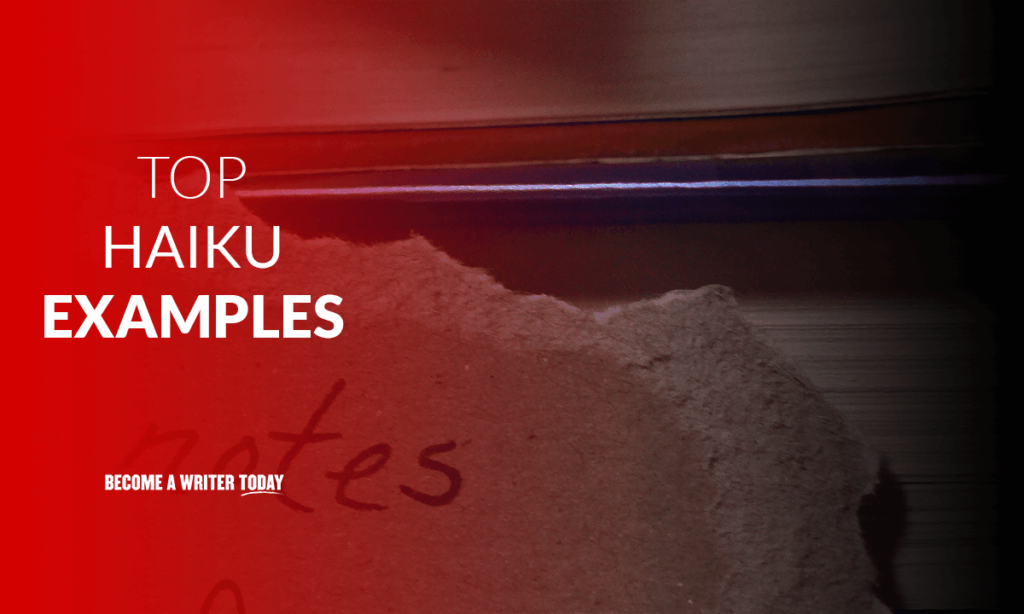Haikus are hard to write, but this list of 10 haiku examples will help you learn how to master the art form.
Haiku poetry is a fun way to play with the rhythm of a poem, not its rhyming pattern, to create poetry. This form of Japanese poetry uses just 17 syllables to create an unrhymed verse.
Japanese haikus have three lines. The first line and the last line have five syllables, while the second line has seven. This form of poetry originated in Japan in the seventeenth century, and it received its name in the nineteenth century. This ancient poetic form has also become a part of English literary history.
To learn more about haiku, take a look at these haiku examples that include both historic and modern works.
Contents

1. Matsuo Basho
Matsuo Basho was a seventeenth-century Japanese poet who historians consider to be the best writer of this genre. Some of his famous haikus include these:
“An old silent pond . . .
Matsuo Basho
A frog jumps into the pond
Splash! Silent again.”
“Autumn moonlight –
Matsuo Basho
A worm digs silently
Into the chestnut”
2. Yosa Buson
Yosa Buson wrote haikus in the eighteenth century. Man of his have themes of the natural world, and, like Basho, Buson is considered a haiku master. Here are some English language translations of his works:
“Light of the moon
Yosa Buson
Moves west, flowers’ shadows
Creep eastward.”
“A summer river being crossed
Yosa Buson
How pleasing
With sandals in my hands!”
3. Masaoka Shiki

Writing in the late nineteenth century, Shiki revived the poetic form and gave modern haiku its style. These haiku poems create imagery with their creative use of the limited number of syllables.
“For love and for hate
Masaoka Shiki
I swat a fly and offer it
to an ant.”
“After killing
Masaoka Shiki
A spider, how lonely I feel
in the cold of night.”
4. Natsume Soseki
Natsume Soseki is one of the more modern Japanese haiku writers. In addition to his haikus, he wrote novels and fairy tales. Like many Japanese poets, he focused a lot of his haiku writing on nature.
“Plum flower temple:
Natsume Soseki
voices rise
From the foothills.”
“The lamp once out
Natsume Soseki
Cool stars enter
The window frame.”
5. Kobayashi Issa
The works of Issa came on the scene in the late 1700s. This poet was famous for his unique take on natural wonders, like a snail climbing a mountain. The poems do lose some of their meter when translated into English:
“O snail
Kobayashi Issa
Climb Mount Fuji,
But slowly, slowly!”
“Trusting the Buddha, good and bad,
Kobayashi Issa
I bid farewell
To the departing year.”
6. Jack Kerouac
In his book Book of Haikus, Kerouac has many original works and a few haikus that paraphrase his prose. His creative writing shows that the haiku still has an impact on modern literature. He also breaks the rules by not sticking to the five-seven-five pattern of syllables.
“One flower
Jack Kerouac
On the cliffside
Nodding at the canyon.”
“Morning sun –
Jack Kerouac
The purple petal,
Four have fallen.”
7. Ezra Pound

Ezra Pound is an American poet who wrote a number of haiku-like poems. These poems do not follow the strict syllables of a haiku, but they have much of the same imagery.
In a Station of the Metro
“The apparition of these faces in the crowd;
Ezra Pound
Petals on a wet, black bough.”
Alba
“As cool as the pale wet leaves
Ezra Poun
of lily-of-the-valley
She lay beside me in the dawn.”
8. Katsushika Hokusai
A follower of Basho, Hokusai is another of the Japanese haiku poets who mastered the art form. In addition to writing haiku, he was also a famous Japanese painter. Some of the beauty of his poetry is lost in translation, but here are some examples:
“I write, erase, rewrite
Katsushika Hokusai
Erase again, and then
A poppy blooms.”
“As a soul
Katsushika Hokusai
I’ll stroll on the summer field
For a past time.”
9. Sonia Sanches
Sonia Sanches is a modern-day Haiku writer. She writes about American themes, using the same imagery ancient Japanese poets did, but with things, American writers are more familiar with.
“Young Chicago
Sonia Sanches
Stutterer whistling
More than flesh.”
“In this southern
Sonia Sanches
classroom summer settles
into winter.”
10. Ravi Shankar
Ravi Shankar takes a twist on the haiku by creating longer poems that have stanzas written in haiku. The stanzas themselves follow the haiku pattern well. “Lines on Skull” is one of his most famous. It reads:
“Start spirit: behold
Ravi Shankar
the skull. A living head loved
earth. My bones resign.
the worm, lips to hold
sparkling grape’s slimy circle,
shape of reptile’s food.”
Poetry Resources
10 Sonnet Examples From Ancient Italy To Today
10 Ballad Examples Everyone Should Learn
Top 10 Limerick Examples To Make You Laugh
Free Verse Examples: 12 Top Poems To Consider
Top 10 Ekphrastic Poem Examples